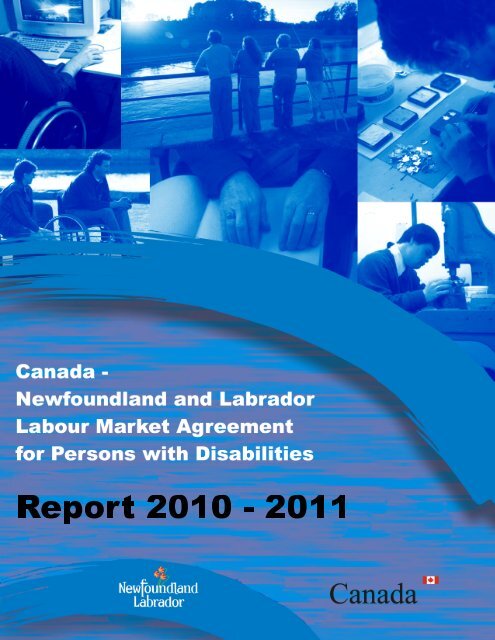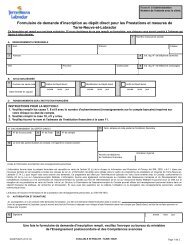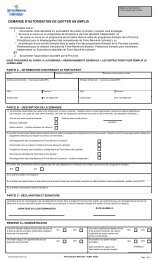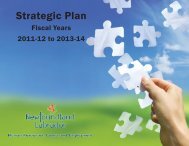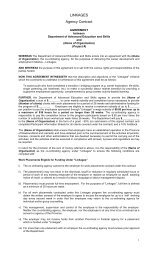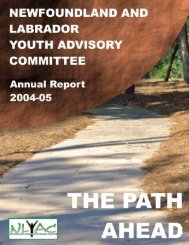Report - Department of Advanced Education and Skills ...
Report - Department of Advanced Education and Skills ...
Report - Department of Advanced Education and Skills ...
You also want an ePaper? Increase the reach of your titles
YUMPU automatically turns print PDFs into web optimized ePapers that Google loves.
Canada-Newfoundl<strong>and</strong> <strong>and</strong> Labrador Labour Market Agreement for Persons with Disabilities (LMAPD)Introduction<strong>Report</strong> 2010-2011The Government <strong>of</strong> Newfoundl<strong>and</strong> <strong>and</strong> Labrador is pleased to present the Canada-Newfoundl<strong>and</strong> <strong>and</strong> LabradorLabour Market Agreement for Persons with Disabilities (LMAPD) <strong>Report</strong> 2010-2011.This report supplements the information provided in our previous annual reports on the programs <strong>and</strong> services costsharedwith the federal government under the Canada-Newfoundl<strong>and</strong> <strong>and</strong> Labrador Labour Market Agreement forPersons with Disabilities (LMAPD). The LMAPD is the successor agreement to the Canada-Newfoundl<strong>and</strong> <strong>and</strong>Labrador Employability Assistance for People with Disabilities (EAPD) Agreement <strong>and</strong> came into effect April 1,2004. This agreement originally had effect from April 1, 2004 to March 31, 2006 <strong>and</strong> has been extended until March31, 2013The report includes objectives, descriptions, target populations <strong>and</strong> planned expenditures for programs <strong>and</strong> servicesfunded under the LMAPD <strong>and</strong> related statistical <strong>and</strong> financial information. Under the Multilateral Framework forLabour Market Agreements for Persons with Disabilities governments agreed to report on societal indicators <strong>of</strong> labourmarket participation for adults with disabilities in the province <strong>of</strong> Newfoundl<strong>and</strong> <strong>and</strong> Labrador <strong>and</strong> this information isalso provided. The Canada–Newfoundl<strong>and</strong> <strong>and</strong> Labrador (NL) Labour Market Agreement for Persons with Disabilities(LMAPD) is working to enhance the labour market participation <strong>of</strong> persons with disabilities by breaking down barriersto employment, increasing education <strong>and</strong> training outcomes, thereby improving employment opportunities for personswith disabilities. The province <strong>of</strong> Newfoundl<strong>and</strong> <strong>and</strong> Labrador is committed to the reduction <strong>of</strong> poverty <strong>and</strong> socialexclusion for all citizens <strong>of</strong> the province. The LMAPD is a significant tool in addressing the needs <strong>of</strong> persons withdisabilities <strong>and</strong> helping persons with disabilities move out <strong>of</strong> poverty by providing the resources to help individualsprepare for, attain, <strong>and</strong> maintain meaningful employment in the community.In 2010-2011 Newfoundl<strong>and</strong> <strong>and</strong> Labrador spent a total <strong>of</strong> $17.5 on programs <strong>and</strong> services funded under theLMAPD agreement, <strong>of</strong> which the federal contribution was $4.6 million.There are 16 employment related programs <strong>and</strong> services for persons with disabilities funded under this agreement.These programs <strong>and</strong> services are delivered by 4 departments: Human Resources, Labour <strong>and</strong> Employment, Health<strong>and</strong> Community Services, <strong>Education</strong> <strong>and</strong> the Public Service Secretariat.In 2010-2011, 5785 clients were served under programs <strong>and</strong> services funded under LMAPD.In 2010-2011, 745 individuals reported obtaining or maintaining employment as a result <strong>of</strong> a program or service,where this indicator was relevant for the program or service being <strong>of</strong>fered.1
Canada-Newfoundl<strong>and</strong> <strong>and</strong> Labrador Labour Market Agreement for Persons with Disabilities (LMAPD)Background<strong>Report</strong> 2010-2011In December 2003, Federal/Provincial/Territorial/Ministers Responsible for Social Services approved the MultilateralFramework for Labour Market Agreements for Persons with Disabilities. The goal <strong>of</strong> the Framework is to improve theemployment situation for persons with disabilities within Newfoundl<strong>and</strong> <strong>and</strong> Labrador. This goal will be fulfilledthrough the pursuit <strong>of</strong> the following three objectives; enhancing the employability <strong>of</strong> persons with disabilities,increasing the employment opportunities available to them, <strong>and</strong> building on the existing knowledge base. Additionally,governments have identified the following five priority areas for action: education <strong>and</strong> training, employmentparticipation, employment opportunities, connecting employers <strong>and</strong> persons with disabilities <strong>and</strong> building knowledge.The LMAPD is the successor agreement to the Canada-Newfoundl<strong>and</strong> <strong>and</strong> Labrador Employability Assistance forPeople with Disabilities (EAPD) Agreement <strong>and</strong> came into effect April 1, 2004. This agreement had effect from April1, 2004 to March 31, 2006 <strong>and</strong> has been extended to March 31, 2013.Societal IndicatorsNewfoundl<strong>and</strong> <strong>and</strong> Labrador, signifies a diverse population <strong>of</strong> working-age persons with disabilities representing avariety <strong>of</strong> skills, abilities <strong>and</strong> needs. More than 10% <strong>of</strong> the population lives with a disability. Our province <strong>and</strong> ourcommunities are enhanced by the diverse perspectives, skills <strong>and</strong> talents that citizens with disabilities contribute. Thecommunity <strong>of</strong> persons with disabilities provides input on issues related to disability <strong>and</strong> strong partnerships have beendeveloped between stakeholders <strong>and</strong> government providing opportunities for collaboration on initiatives to promotethe full inclusion <strong>of</strong> persons with disabilities. The development <strong>of</strong> the Multilateral Framework for Persons withDisabilities also provides an opportunity to strengthen our programs <strong>and</strong> services. Over the course <strong>of</strong> this agreementgovernment continues to engage the community to review current programs <strong>and</strong> services <strong>and</strong> to identify new initiativesin an effort to ensure the effectiveness <strong>and</strong> efficiency <strong>of</strong> existing services <strong>and</strong> to respond to gaps identified.As part <strong>of</strong> the ongoing effort <strong>of</strong> government to provide information to its citizens on programs <strong>and</strong> services providedunder the LMAPD, a number <strong>of</strong> societal indicators <strong>of</strong> labour market participation have been identified. Commonindicators include:1. Employment rate <strong>of</strong> working age persons with disabilities;2. Employment income; <strong>and</strong>3. <strong>Education</strong> attainment.The 2004 baseline report presented societal indicators using data from the Participation <strong>and</strong> Activity Limitation Survey(PALS), Canada’s principal source <strong>of</strong> detailed statistical information about disability issues. PALS was first conductedin 2001 <strong>and</strong> again following the 2006 census. This year’s report uses the Statistics Canada survey, the Survey <strong>of</strong>Labour <strong>and</strong> Income Dynamics (SLID), to present societal indicators. SLID is conducted annually <strong>and</strong> providesinformation about income, employment, education <strong>and</strong> other topics for the adult Canadian population.2
Canada-Newfoundl<strong>and</strong> <strong>and</strong> Labrador Labour Market Agreement for Persons with Disabilities (LMAPD)<strong>Report</strong> 2010-2011Information from SLID, 2009 is tabled below. As the table indicates, working-age persons with disabilities had anemployment level <strong>of</strong> 48% nationally. A total <strong>of</strong> 35% <strong>of</strong> adults with disabilities reported as being unemployed or notparticipating in the labour force <strong>and</strong> 17% reported having a change in their labour market status during the year <strong>and</strong> arerecorded as “Other” in SLID 1 . For the same period working age persons with disabilities in Newfoundl<strong>and</strong> <strong>and</strong>Labrador had an employment rate <strong>of</strong> 36% <strong>and</strong> 46% reported being unemployed or not participating in the labour force.A total <strong>of</strong> 18% <strong>of</strong> those responding from Newfoundl<strong>and</strong> <strong>and</strong> Labrador reported a change in their labour market statusas designated by “Other”. For both Newfoundl<strong>and</strong> <strong>and</strong> Labrador <strong>and</strong> Canada the employment level <strong>of</strong> persons withdisabilities was lower than for the population <strong>of</strong> persons without disabilities.TABLE 1Employment 20097065.96057.75047.846.3percent403035.136.128.72013.317.120.713.617.5100EmployedUnemployed orNILFOther Employed Unemployed orNILFOtherCanadaNewfoundl<strong>and</strong> <strong>and</strong> LabradorSource: SLID 2009Persons with DisabilitiesPersons without Disabilities1 Labour market status is reported using a variable from SLID signifying annual labour market status. That is,individuals are considered “employed” only if they are employed for the entire year <strong>and</strong> similarly for thoseunemployed <strong>and</strong> not in the labour force. People who are employed for only part <strong>of</strong> the year or who experience otherchanges in their labour market status are included in the “other” category. This approach provides a conservative orsomewhat understated picture <strong>of</strong> overall employment experience.3
Canada-Newfoundl<strong>and</strong> <strong>and</strong> Labrador Labour Market Agreement for Persons with Disabilities (LMAPD)<strong>Report</strong> 2010-2011Adults with disabilities in Canada are more likely to report having no employment income than their counterpartswithout disabilities (34% compared to 13%). For Newfoundl<strong>and</strong> <strong>and</strong> Labrador, the numbers <strong>of</strong> adults reporting noemployment income were 42% <strong>and</strong> 13% respectively for persons with disabilities <strong>and</strong> their counterparts withoutdisabilities. Both in Newfoundl<strong>and</strong> <strong>and</strong> Labrador <strong>and</strong> in Canada generally, income level is a significant issue for allindividuals with disabilities. Among those persons with disabilities who are employed nationally, 46.5% reportincomes below $20,000. In Newfoundl<strong>and</strong> <strong>and</strong> Labrador 53.6% <strong>of</strong> persons with disabilities who were employedearned less than $20,000. As indicated by Tables 2 & 3 below.TABLE 2Earnings 20091009086.086.180706065.657.7percent504033.542.3302013.4 12.6100Had Earnings Did Not Have Earnings Had Earnings Did Not Have EarningsCanadaPersons with DisabilitiesPersons without DisabilitiesNewfoundl<strong>and</strong> <strong>and</strong> LabradorSource: SLID 20094
Canada-Newfoundl<strong>and</strong> <strong>and</strong> Labrador Labour Market Agreement for Persons with Disabilities (LMAPD)<strong>Report</strong> 2010-2011TABLE 3Earnings Level 20097063.96053.456.35046.4percent40302019.812.026.724.122.913.930.729.9100$1 - $4,999 $5,000 - $19,999 $20,000 <strong>and</strong> over $1 - $4,999 $5,000 - $19,999 $20,000 <strong>and</strong> overCanadaPersons with DisabilitiesPersons without DisabilitiesNewfoundl<strong>and</strong> <strong>and</strong> LabradorSource: SLID 20095
Canada-Newfoundl<strong>and</strong> <strong>and</strong> Labrador Labour Market Agreement for Persons with Disabilities (LMAPD)<strong>Report</strong> 2010-2011The data from SLID for 2009 included in this report continues to enhance our underst<strong>and</strong>ing <strong>and</strong> knowledge <strong>of</strong> themany ways in which disability affects the lives <strong>of</strong> persons with disabilities. The data which has been reported oneducation, income <strong>and</strong> employment reflects the challenges which continue to be faced by persons with disabilities inpursuing full participation in society. The Province will use this information to focus programs <strong>and</strong> services. Thepositive effects <strong>of</strong> our efforts to respond to the needs <strong>of</strong> persons with disabilities will result in increases in the labourmarket participation <strong>of</strong> persons with disabilities <strong>and</strong> improved social <strong>and</strong> economic well-being.Programs <strong>and</strong> ServicesThe Canada-Newfoundl<strong>and</strong> <strong>and</strong> Labrador Labour Market Agreement for Persons with Disabilities (LMAPD) providescost-shared funding for a range <strong>of</strong> provincially-delivered programs <strong>and</strong> services that enhance the labour marketparticipation <strong>of</strong> working age adults with disabilities. These programs <strong>and</strong> services provide the skills, experience <strong>and</strong>related supports necessary to prepare people with disabilities for employment or to help them retain employment.In Newfoundl<strong>and</strong> <strong>and</strong> Labrador, the <strong>Department</strong>s’ <strong>of</strong> Human Resources, Labour <strong>and</strong> Employment, Health <strong>and</strong>Community Services, <strong>Education</strong> <strong>and</strong> Public Service Secretariat provide programs <strong>and</strong> services to assist persons withdisabilities. In addition, government partners with community agencies to provide programs <strong>and</strong> services.Interventions to improve the employability <strong>of</strong> persons with disabilities are provided in response to individual need. Assuch, interventions to assist with employment preparation <strong>and</strong> attachment to the workforce, or to address vocationalcrisis tend to vary in intensity <strong>and</strong> duration.The LMAPD Annual Plan for 2011-2012 is attached as Appendix A. The Annual Plan provides information on theindividual program objectives, descriptions, target populations <strong>and</strong> planned expenditures for the 2011-2012 fiscal yearfunded under this agreement.Service DeliveryHuman Resources, Labour <strong>and</strong> EmploymentFunding under the LMAPD provides for a range <strong>of</strong> services <strong>and</strong> programs to assist persons with disabilities to acquirethe skills, experience <strong>and</strong> supports necessary to successfully prepare for, obtain <strong>and</strong> maintain employment. Clients areprovided with services <strong>and</strong> supports needed to pursue post-secondary education through the Training ServicesProgram. Individuals are supported in employment through the Supported Employment Program. Clients withdisabilities are provided access to career planning, job search assistance <strong>and</strong> on-the-job training through communitypartnerships under the Grants to Community Partners Program <strong>and</strong> through provincial Career Work Centres.The Training Services Program provides supports <strong>and</strong> services to eligible individuals with disabilities who wish topursue post-secondary training or employment as part <strong>of</strong> an employment plan collaboratively developed withpr<strong>of</strong>essional staff <strong>of</strong> the <strong>Department</strong> <strong>of</strong> Human Resources, Labour <strong>and</strong> Employment. Benefits <strong>and</strong> services availableinclude: the provision <strong>of</strong> living allowances during the period <strong>of</strong> training; transportation costs to attend a post-7
Canada-Newfoundl<strong>and</strong> <strong>and</strong> Labrador Labour Market Agreement for Persons with Disabilities (LMAPD)<strong>Report</strong> 2010-2011secondary institution; tuition <strong>and</strong> student fees; text books <strong>and</strong> disability-related supports, such as: interpreters <strong>and</strong>/oradaptive technology. In addition, active programs such as employment counseling <strong>and</strong> assessment, employmentplanning, pre-employment training, skills training, the provision <strong>of</strong> technical aids <strong>and</strong> other supports assist individualsobtain access to job opportunities <strong>and</strong> training.The Supported Employment Program works in partnership with community employment groups to developemployment opportunities for people who have a developmental disability. The Supported Employment Programprovides the necessary support to allow individuals with developmental disabilities to participate in meaningful,integrated employment in the community. Supports range from orientation <strong>and</strong> work analysis, to full-time supportfrom a job trainer to ensure that the required duties <strong>of</strong> the job are completed to the satisfaction <strong>of</strong> the employer. Thetype <strong>of</strong> employment options which may be supported include: individual supported employment in the labour force;contractual employment; self-employment <strong>and</strong> small business development.The <strong>Department</strong> <strong>of</strong> Human Resources, Labour <strong>and</strong> Employment provides funding to a number <strong>of</strong> community partnersto provide services <strong>and</strong> supports to eligible individuals with disabilities which are consistent <strong>and</strong> compatible with them<strong>and</strong>ate <strong>of</strong> the <strong>Department</strong> <strong>of</strong> Human Resources, Labour <strong>and</strong> Employment <strong>and</strong> the goals <strong>and</strong> objectives <strong>of</strong> theDivision <strong>of</strong> Career Employment <strong>and</strong> Youth Services. These community partners deliver services which assistindividuals with disabilities prepare for, attain or maintain employment. Services include information <strong>and</strong> referral toappropriate services <strong>and</strong> programs, assessment, employment <strong>and</strong> career counseling, skills training, <strong>and</strong> provision <strong>of</strong>technical aids <strong>and</strong> other enabling supports.<strong>Education</strong>The <strong>Department</strong> <strong>of</strong> <strong>Education</strong> provides funding to post-secondary institutions to support the participation <strong>of</strong> studentswith disabilities in education <strong>and</strong> training programs. Post-secondary institutions <strong>of</strong>fer assessment <strong>and</strong> traininginterventions focused on removing disability-related barriers in post-secondary training environments. Students withdisabilities are provided support while in training <strong>and</strong> on job sites. Assistive <strong>and</strong> adaptive technologies, attendants <strong>and</strong>tutors may be provided to enable persons with disabilities to participate <strong>and</strong> complete post-secondary training. Theseservices enhance students' capacity to participate <strong>and</strong> compete in post-secondary training <strong>and</strong> in the labour force.Health <strong>and</strong> Community ServicesThe <strong>Department</strong> <strong>of</strong> Health <strong>and</strong> Community Services provides funding to a variety <strong>of</strong> community agencies to supportindividuals with disabilities, <strong>and</strong> to Regional Health Authorities to support persons accessing addictions services.Activities include: rehabilitative services to help an individual adapt to a disability <strong>and</strong> address barriers to meaningfulparticipation in society; including employment; supports to enable adaptation to work environments; assistance withmaintaining health, technical aids <strong>and</strong> housing; training, employment preparation <strong>and</strong> employment counseling; supportto find <strong>and</strong> maintain employment; helping adults access services that would help them prepare to enter <strong>and</strong> continueinvolvement in the labour force; <strong>and</strong> rehabilitative supports to persons who are working.8
Canada-Newfoundl<strong>and</strong> <strong>and</strong> Labrador Labour Market Agreement for Persons with Disabilities (LMAPD)Public Service Secretariat<strong>Report</strong> 2010-2011Public Service Secretariat delivers the Opening Doors program which provides opportunities for individuals withdisabilities to obtain employment within the province's public service. In addition, Opening Doors providesinformation, advice <strong>and</strong> training, on issues related to the employment <strong>of</strong> individuals with disabilities, to directors <strong>of</strong>human resources, managers, supervisors <strong>and</strong> executives within the provincial public sector. Opening Doors alsooperates a Career Resource Centre that provides a wide range <strong>of</strong> accessible employment assistance services.ResultsThe following tables include program results <strong>and</strong> the total expenditures on programs under the LMAPD for the periods<strong>of</strong> 2004-05 to 2010-11 inclusive <strong>and</strong> projected expenditures for 2011-12 as well as the Canada <strong>and</strong> Newfoundl<strong>and</strong> <strong>and</strong>Labrador contributions.Newfoundl<strong>and</strong> & Labrador Labour Market Agreement forPersons with Disabilities <strong>Report</strong>, 2010-2011EXPENDITURESProgramServices 2004-2005 2005-2006 2006-2007 2007-2008 2008-2009 2009-20102010-2011(unaudited)2011-2012(projected)HumanResources,Labour &Employment$6,855.600 $6,916,600 $7,341,600 $8,448,815 $8,448,815 $10,858,000 $11,632.302 $11,951,827<strong>Education</strong>$543,537 $ 543,537 $543,537 $476,300 $1,052,423 $1,241,764 $1,265,181$1,355,997Health &CommunityServices$1,270,811 $1,270,811 $1,270,811 $1,512,911 $1,270,811 $909,305 $909,305 $909,305Public ServiceSecretariat$2,835,000 $2,837,100 $2,920,200 $3,305,800 3,691,000 $3,338,574 $3,755,701 $4,298,800ProvincialContribution$6,925,794 $6,988,894 $7,413,894 $9,164,672 $9,883,895 $11,768,489 $12,983,335 $13,936,775Government <strong>of</strong>CanadaContribution$4,579,154 $4,579,154 $4,579,154 $4,579,154 $4,579,154 $4,579,154 $4,579,154 $4,579,154TotalExpenditures$11,504,948 $11,568,048 $11,993,048 $13,743,826 $14,463,079 $16,347,643 $17,562,489 $18,515,9299
Canada-Newfoundl<strong>and</strong> <strong>and</strong> Labrador Labour Market Agreement for Persons with Disabilities (LMAPD)<strong>Report</strong> 2010-2011Program Results2004-20052005-20062006-20072007-20082008-2009200920102010-2011Training Services ProgramNumber <strong>of</strong> people participating in programs <strong>and</strong>/orservicesNumber <strong>of</strong> people employed as a result <strong>of</strong> a program<strong>and</strong>/or serviceSupported Employment ProgramNumber <strong>of</strong> people participating in programs <strong>and</strong>/orservicesNumber <strong>of</strong> people employed as a result <strong>of</strong> a program<strong>and</strong>/or serviceGrants to Community PartnersNumber <strong>of</strong> people participating in programs <strong>and</strong>/orservicesNumber <strong>of</strong> people employed as a result <strong>of</strong> a program<strong>and</strong>/or servicePublic Service SecretariatNumber <strong>of</strong> people participating in programs <strong>and</strong>/orservicesNumber <strong>of</strong> people employed as a result <strong>of</strong> a program<strong>and</strong>/or service<strong>Education</strong>Number <strong>of</strong> people participating in programs <strong>and</strong>/orservicesNumber <strong>of</strong> people employed as a result <strong>of</strong> a program<strong>and</strong>/or serviceHealth <strong>and</strong> Community ServicesNumber <strong>of</strong> people participating in programs <strong>and</strong>/orservicesNumber <strong>of</strong> people employed as a result <strong>of</strong> a program<strong>and</strong>/or service347 283 304 209 230 332 351N/A N/A N/A N/A N/A N/A N/A1000 1399 1300 1279 1279 1265 1308601 675 709 774 700 779 498347 485 547 550 600 1200 1000N/A N/A N/A N/A N/A N/A N/A1,317 1,196 1,247 1,170 1,224 1344 110748 62 60 43 54 79 62234 316 407 457 548 520 509N/A N/A N/A N/A N/A N/A N/A2,930 2,773 2,573 2373 1510 1510 1510249 330 250 154 185 185 185(Some people may be included more than once as a result <strong>of</strong> having participated in more than one type <strong>of</strong>intervention.)10
Canada-Newfoundl<strong>and</strong> <strong>and</strong> Labrador Labour Market Agreement for Persons with Disabilities (LMAPD)<strong>Report</strong> 2010-2011ConclusionThis report continues our tradition <strong>of</strong> working in collaboration with the federal government to address the issuesaffecting persons with disabilities. In April 2004, the Governments <strong>of</strong> Newfoundl<strong>and</strong> <strong>and</strong> Labrador <strong>and</strong> Canadasigned the Labour Market Agreement for Persons with Disabilities (LMAPD). The LMAPD confirms thecommitment <strong>of</strong> the Government <strong>of</strong> Newfoundl<strong>and</strong> <strong>and</strong> Labrador <strong>and</strong> Canada to work towards ensuring thatNewfoundl<strong>and</strong>ers <strong>and</strong> Labradorians with disabilities can participate successfully in the labour market. This reportcontinues to build on <strong>and</strong> describes the important programs <strong>and</strong> services that are funded under the LMAPD in theprovince to help persons with disabilities integrate into the workplace. It outlines provincial objectives, programdescriptions, target populations <strong>and</strong> planned expenditures intended to increase the employment opportunities <strong>and</strong>enhance the employability <strong>of</strong> Newfoundl<strong>and</strong>ers <strong>and</strong> Labradorians with disabilities.The Government <strong>of</strong> Newfoundl<strong>and</strong> <strong>and</strong> Labrador continues to work in partnership with the Government <strong>of</strong> Canada<strong>and</strong> the community on approaches to best meet the needs <strong>of</strong> persons with disabilities <strong>and</strong> to achieve the objectives <strong>of</strong>the LMAPD.11
Canada-Newfoundl<strong>and</strong> <strong>and</strong> Labrador Labour Market Agreement for Persons with Disabilities (LMAPD)<strong>Report</strong> 2010-2011APPENDICESi
Canada-Newfoundl<strong>and</strong> <strong>and</strong> Labrador Labour Market Agreement for Persons with Disabilities (LMAPD)<strong>Report</strong> 2010-2011ANNUAL PLAN 2011-2012The Annual Plan provides an overview <strong>of</strong> the provincial programs <strong>and</strong> expenditures that are being submitted for cost sharing under the terms <strong>of</strong> the Canada-Newfoundl<strong>and</strong> LabourMarket Agreement for Persons with Disabilities. The Plan contains the following components:A. <strong>Department</strong>al Program Expenditure SummaryB. Provincial Financial Summaryii
Canada-Newfoundl<strong>and</strong> <strong>and</strong> Labrador Labour Market Agreement for Persons with Disabilities (LMAPD)<strong>Report</strong> 2010-2011Labour Market Agreement for Persons with Disabilities Annual Plan – 2011/2012<strong>Department</strong>al Program Expenditure SummaryProvincial <strong>Department</strong>And Agency/ProgramServicesArea <strong>of</strong>PriorityTargetPopulationProgramDescriptionDEPARTMENT OF HUMAN RESOURCES, LABOUR AND EMPLOYMENTTraining Services1. <strong>Education</strong> <strong>and</strong>Training2. Building on theexistingknowledge basePersons with disabilitieswho wish to pursue postsecondary training oremployment.Employment Corporations(job trainers)1. EmploymentParticipation2. EmploymentOpportunities3. ConnectingEmployers withPersons withDisabilitiesPersons withdevelopmentaldisabilities who wish topursue employment.The Training Services Program provides supports <strong>and</strong> services toeligible individuals with disabilities who wish to pursue postsecondary training or employment as part <strong>of</strong> a collaborativelydeveloped employment plan with pr<strong>of</strong>essional staff <strong>of</strong> the <strong>Department</strong><strong>of</strong> Human Resources, Labour <strong>and</strong> Employment. Benefits <strong>and</strong> servicesavailable include: the provision <strong>of</strong> financial living allowances duringthe period <strong>of</strong> training, transportation costs to attend a post secondaryinstitution, tuition <strong>and</strong> student fees, text books, disability-relatedsupports such as interpreters <strong>and</strong>/or tutors.In addition, active programs in employment counseling <strong>and</strong>assessment, employment planning, pre-employment training, skillstraining, technical aids <strong>and</strong> other supports assist individuals obtainaccess to job opportunities <strong>and</strong> training.This program area works in partnership with community groups todevelop employment for people who have a developmental disability.Community groups (sometimes employment corporations), through anemployment coordinator, work in a particular community to developjobs for eligible participants. The Supported Employment programprovides the necessary support to allow individuals withdevelopmental disabilities to participate in meaningful, integratedemployment in the community.Funding is available to provide the support necessary to allow theindividual to experience success in the workplace. Supports availablerange from orientation <strong>and</strong> work analysis to full time support from ajob trainer to ensure that the required duties <strong>of</strong> the job are completedto the satisfaction <strong>of</strong> the employer. The type <strong>of</strong> employment optionswhich may be supported include: individual supported employment inthe labour force, contractual employment, self employment <strong>and</strong> smallbusiness development.ShareableCostEstimate2011/2012$2,767,100$6,905,300iii
Labour Market Agreement for Persons with Disabilities Annual Plan – 2011/2012<strong>Department</strong>al Program Expenditure SummaryProvincial <strong>Department</strong>And Agency/ProgramServicesArea <strong>of</strong>PriorityTargetPopulationDEPARTMENT OF HUMAN RESOURCES, LABOUR AND EMPLOYMENTWork OrientedRehabilitation Centres(WORC)1. EmploymentParticipation2. EmploymentOpportunities3. ConnectingEmployers <strong>and</strong>Persons withDisabilitiesPersons withdevelopmentaldisabilities who wish topursue employment.ProgramDescriptionThere are two Work Oriented Rehabilitation Centres, (WORC), in theprovince located in Lewisporte <strong>and</strong> St. John’s. These agencies providejob placement services <strong>and</strong> employment training for adults withdevelopmental disabilities. These agencies also provide work relatedopportunities prior to employment in the community. Individuals canapply directly to the organization or to the local <strong>of</strong>fice <strong>of</strong> HumanResources, Labour <strong>and</strong> Employment.ShareableCostEstimate2011/2012$433,200Newfoundl<strong>and</strong> CoordinatingCouncil on Deafness(NCCD)HRLE AdministrativeServices1. <strong>Education</strong> <strong>and</strong>Training1. <strong>Education</strong> <strong>and</strong>Training2. EmploymentParticipation3. EmploymentOpportunities4. ConnectingEmployers <strong>and</strong>Persons withDisabilities5. Building on theexistingknowledge basePersons with disabilitieswho wish to pursue postsecondary training oremployment.Persons with disabilitieswho wish to pursue postsecondary training oremployment.Funding is provided to NCCD for the provision <strong>of</strong> educational supportservices for post-secondary students who are hard <strong>of</strong> hearing or deaf.Services provided to individuals include vocational counseling, tutorialservices, note-taking services, orientation services <strong>and</strong> provision <strong>and</strong>maintenance <strong>of</strong> personalized assistive listening devices <strong>and</strong> accessories.Funding for the salary <strong>and</strong> associated costs to deliver the programs <strong>and</strong>services <strong>of</strong> the Canada-Newfoundl<strong>and</strong> <strong>and</strong> Labrador labour MarketAgreement for Persons with Disabilities. Funding includes salary costsfor Director, Program <strong>and</strong> Policy Development Specialist,Administrative Officer <strong>and</strong> Word Processing Equipment Operator.$44,800$244,800
Canada-Newfoundl<strong>and</strong> <strong>and</strong> Labrador Labour Market Agreement for Persons with Disabilities (LMAPD)<strong>Report</strong> 2010-2011Labour Market Agreement for Persons with Disabilities Annual Plan – 2011/2012<strong>Department</strong>al Program Expenditure SummaryProvincial <strong>Department</strong>And Agency/ProgramServicesArea <strong>of</strong>PriorityTargetPopulationProgramDescriptionDEPARTMENT OF HUMAN RESOURCES, LABOUR AND EMPLOYMENTIndependent Living ResourceCentre – Full Steam AheadStrategic InitiativesCanadian ParaplegicAssociation (CPA)1. <strong>Education</strong> <strong>and</strong>Training2. EmploymentParticipation3. EmploymentOpportunities4. ConnectingEmployers <strong>and</strong>Persons withDisabilities5. Building on theexistingknowledge base1. <strong>Education</strong> <strong>and</strong>Training2. EmploymentParticipation3. EmploymentOpportunities4. ConnectingEmployers <strong>and</strong>Persons withDisabilities5. Building on theexistingknowledge base1. EmploymentParticipation2. EmploymentOpportunities3. ConnectingEmployers <strong>and</strong>Persons withDisabilitiesPersons withDisabilities who wish topursue employment.Persons with disabilitieswho wish to pursue postsecondary training oremploymentPersons with disabilitieswho wish to pursue postsecondary training oremployment.The Full Steam Ahead (FSA) Project provides opportunities for people withdisabilities to prepare for, attain <strong>and</strong> maintain employment. The project providesinformation <strong>and</strong> learning opportunities about the labour force, pre-employmentskills development, employment resources, disability related accommodation,rights in the workplace, self-employment <strong>and</strong> access to generic employmentrelated programs.Full Steam Ahead assists individuals in making employment choices, weighingout risks, <strong>and</strong> gaining ownership over their career development. The programsupports individuals to get past the barriers <strong>and</strong> access other employmentservices to develop career related knowledge <strong>and</strong> job search skills <strong>and</strong> acquirepaid employment.Funding for Strategic initiatives to increase labour market participation <strong>and</strong>reduce barriers to employment for persons with disabilities. Initiatives include:the provision <strong>of</strong> disability related supports to adults who wish to participate in ormaintain employment; wage subsidy program for persons with disabilities topromote employment attachment; internships for persons with disabilities topromote the use <strong>of</strong> technology in employment; grants to community partners <strong>and</strong>public awareness.This initiative provides educational <strong>and</strong> employment counseling, assessment <strong>and</strong>placement services for eligible persons with disabilities in three locationsthroughout the province. Individuals with disabilities are assisted to find <strong>and</strong>obtain employment placements or access to educational placements that enhanceemployability.ShareableCostEstimate2011/2012$53,227$1,256,700Total $11,951,827$246,700v
Canada-Newfoundl<strong>and</strong> <strong>and</strong> Labrador Labour Market Agreement for Persons with Disabilities (LMAPD)<strong>Report</strong> 2010-2011Labour Market Agreement for Persons with Disabilities Annual Plan – 2011/2012<strong>Department</strong>al Program Expenditure SummaryProvincial <strong>Department</strong>And Agency/ProgramServicesArea <strong>of</strong>PriorityTargetPopulationProgramDescriptionDEPARTMENT OF HEALTH AND COMMUNITY SERVICESHCS AddictionsProgramsAdministrationAddictions Services1.<strong>Education</strong> <strong>and</strong>Training2.EmploymentParticipation3.EmploymentOpportunities4.ConnectingEmployers <strong>and</strong>Persons withDisabilities5.Building on the existingknowledge base1.<strong>Education</strong> <strong>and</strong>Training2.EmploymentParticipationThe client groupsserved are personsseeking servicesbecause <strong>of</strong> anaddiction.The client groupsserved are personsseeking servicesbecause <strong>of</strong> anaddiction.The program <strong>of</strong> addiction services, funded in part by this agreement isdistributed as two program components: (1) Addictions Administration<strong>and</strong> (2) Addictions ServicesThe Addictions Administration component <strong>of</strong> the program provides forthe salary, support staff, travel <strong>and</strong> training costs to manage <strong>and</strong> deliverthe addictions program.Pr<strong>of</strong>essional counselors complete a psycho-social assessment todetermine the program recommended for the individual. A range <strong>of</strong>community based treatment <strong>and</strong> intervention services are provided toeffectively meet the needs <strong>of</strong> each individual. The services fundedprovide a range <strong>of</strong> programs that directly encourage, support <strong>and</strong>enhance the employment experience <strong>of</strong> persons grappling withaddictions. Some examples <strong>of</strong> program activities may include:preparatory pre-employment experiences, individual supports toattain/maintain employment <strong>and</strong> supports in times <strong>of</strong> job crisis.Grants to Agencies The program <strong>of</strong> grants to agencies provides funding to agencies <strong>and</strong>focuses on employment support for persons with disabilities. Thisprogram provides a range <strong>of</strong> services that directly supports theemployment experiences <strong>of</strong> persons with disabilities.The agencies that are funded are:(1) The Canadian National Institute for the Blind;(2) Canadian Paraplegic Association;(3) Interpreting Services <strong>of</strong> Newfoundl<strong>and</strong> <strong>and</strong> Labrador.ShareableCostEstimate2011/2012$65,405$187,000vi
Canada-Newfoundl<strong>and</strong> <strong>and</strong> Labrador Labour Market Agreement for Persons with Disabilities (LMAPD)<strong>Report</strong> 2010-2011Labour Market Agreement for Persons with Disabilities Annual Plan – 2011/2012<strong>Department</strong>al Program Expenditure SummaryProvincial<strong>Department</strong>And Agency/ProgramServicesArea <strong>of</strong>PriorityTargetPopulationProgramDescriptionDEPARTMENT OF HEALTH AND COMMUNITY SERVICESCanadian NationalInstitute for the BlindCanadian ParaplegicAssociationInterpreting Services <strong>of</strong>Newfoundl<strong>and</strong> <strong>and</strong>Labrador1.<strong>Education</strong> <strong>and</strong> Training2.Employment Participation3.EmploymentOpportunities4.Connecting Employers<strong>and</strong> Persons withDisabilities5.Building on the existingknowledge base1.<strong>Education</strong> <strong>and</strong> Training2.Employment Participation3.EmploymentOpportunities4.Connecting Employers<strong>and</strong> Persons withDisabilities5.Building on the existingknowledge base1.<strong>Education</strong> <strong>and</strong> Training2.Employment Participation3.EmploymentOpportunities4.Connecting Employers <strong>and</strong>Persons with DisabilitiesPersons withdisabilities who areintending to preparefor, seek <strong>and</strong>maintain employmentor training.Persons withdisabilities who areintending to preparefor, seek <strong>and</strong>maintain employmentor training.Persons withdisabilities who areintending to preparefor, seek <strong>and</strong>maintain employmentor training.The CNIB has existed in this province since 1920 <strong>and</strong> currentlyprovides services from three service centres: St. John’s, CornerBrook <strong>and</strong> Gr<strong>and</strong> Falls-Windsor. Services funded include:counseling <strong>and</strong> referral; orientation <strong>and</strong> mobility training,rehabilitation teaching; technical aids services <strong>and</strong> transcription(braille <strong>and</strong> audio) services. Services prepare clients foremployment, assist with job retention <strong>and</strong> support clients enrolled intraining programs. The CNIB provides individualized instruction toensure clients have the mobility required to travel to work,rehabilitation training, the skills required to access print <strong>and</strong> braillematerials, <strong>and</strong> many other blindness specific services necessary forsuccess in the workplace <strong>and</strong>/or training programs.The CPA began its services in NL in 1976 <strong>and</strong> has providedoutcome-result oriented rehabilitation, vocational <strong>and</strong> employmentservices to people with physical disabilities since that time. CPAdelivers its services through vocational employment counselors inthe province who assist clients in the development <strong>of</strong> realisticattainable vocational goals. The CPA programs work within thefollowing areas <strong>and</strong> include: personal counseling; mobilityequipment; accessible housing; educational <strong>and</strong> vocationalcounseling; employment referrals, placement <strong>and</strong> counseling;transportation; advocacy <strong>and</strong> public awareness; financialmanagement <strong>and</strong> injury prevention.Visual Language Interpretation is a mechanism to facilitatecommunication between deaf or hard <strong>of</strong> hearing persons <strong>and</strong> thehearing population <strong>of</strong> the province. The visual languageinterpretation service provides services in a variety <strong>of</strong> settings usedby persons who are deaf or severely hard <strong>of</strong> hearing using AmericanSign Language (ASL), speech reading <strong>and</strong> elements <strong>of</strong> gesture.Interpreting Services are provided by qualified visual languageinterpreters in areas such as crisis counseling, medical, legal,social services, employment <strong>and</strong> education.ShareableCostEstimate2011/2012$344,900$100,000$212,000Total $909,305vii
Canada-Newfoundl<strong>and</strong> <strong>and</strong> Labrador Labour Market Agreement for Persons with Disabilities (LMAPD)<strong>Report</strong> 2010-2011Labour Market Agreement for Persons with Disabilities Annual Plan – 2011/2012<strong>Department</strong>al Program Expenditure SummaryProvincial<strong>Department</strong>And Agency/ProgramServicesArea <strong>of</strong>PriorityTargetPopulationProgramDescriptionDEPARTMENT OF EDUCATIONPost-Secondary1.<strong>Education</strong> <strong>and</strong> TrainingPrograms (GeneralVocational <strong>and</strong>Waterford Hospital)Persons withdisabilities who wishto pursue postsecondary training.In cooperation with the College <strong>of</strong> the North Atlantic,dedicated staff has been identified at selected campuslocations to assist those persons with disabilities throughthe process <strong>of</strong> acquiring a post-secondary education. TheCollege adheres to a service delivery model specificallydesigned to meet the various needs <strong>of</strong> persons withdisabilities during their course <strong>of</strong> study. At pre-designedstages, College personnel meet with the student <strong>and</strong> theiradvocates <strong>and</strong> any other person or organization deemednecessary to determine the best possible course <strong>of</strong> actionfor the student in light <strong>of</strong> the disability. The <strong>Department</strong>will report on the number <strong>of</strong> students with disabilitiesenrolled at the College, by program, who are usingdisability services, <strong>and</strong> the number <strong>of</strong> graduates withdisabilities at the College on an annual basis.ShareableCostEstimate2011/2012$1,355,997Total $1,355,997viii
Canada-Newfoundl<strong>and</strong> <strong>and</strong> Labrador Labour Market Agreement for Persons with Disabilities (LMAPD)Labour Market Agreement for Persons with Disabilities Annual Plan – 2011/2012<strong>Department</strong>al Program Expenditure SummaryProvincial<strong>Department</strong>And Agency/ProgramServicesArea <strong>of</strong>PriorityTargetPopulationProgramDescriptionPUBLIC SERVICE SECRETARIATOffice <strong>of</strong> EmploymentEquity for Persons withDisabilities1.EmploymentParticipation2.EmploymentOpportunities3.Connecting Employers<strong>and</strong> Persons withDisabilities4.Building on the existingknowledge basePersons withDisabilities who areEmploymentDisadvantaged.The Office <strong>of</strong> Employment Equity for Persons withDisabilities has as its m<strong>and</strong>ate to increase the number <strong>of</strong>persons with disabilities employed in the Public Service. Toachieve this, the Office operates the Opening Doors Program(Permanent <strong>and</strong> Temporary), a Student Summer EmploymentInitiative, <strong>and</strong> career support services.The Opening Doors Program is comprised <strong>of</strong> full time,permanent Opening Doors positions throughout theProvincial Public Service. These positions are designated forpersons with disabilities <strong>and</strong> limited to members <strong>of</strong> thisemployment equity group.As well, this Program delivers a temporary component whichallows for the creation <strong>of</strong> temporary Opening Doors positionsfor a minimum <strong>of</strong> three months to provide persons withdisabilities the opportunity to gain valuable work experience.The objective <strong>of</strong> the Student Summer Employment Programis to provide career-related work experience in the PublicService for post secondary students with disabilities.Summer employment opportunities provide students withpractical skills <strong>and</strong> knowledge to prepare them for their futureentry into the labour market.Career support services are available through the Office toprovide practical job search <strong>and</strong> career counselling assistanceto persons with disabilities registered with the Office.The Office will report on the number <strong>of</strong> persons withdisabilities who are employed in both permanent <strong>and</strong>temporary positions under the Opening Doors Program, thenumber <strong>of</strong> students hired through our Student SummerEmployment Program, <strong>and</strong> the number <strong>of</strong> clients who receiveemployment counseling <strong>and</strong> career support services throughour Office.ShareableCostEstimate2011/2012$4,298,800TOTAL $4,298,800<strong>Report</strong> 2010-2011ix
Canada-Newfoundl<strong>and</strong> <strong>and</strong> Labrador Labour Market Agreement for Persons with Disabilities (LMAPD)<strong>Report</strong> 2010-2011Labour Market Agreement for Persons with Disabilities Annual Plan – 2011/2012<strong>Department</strong>al Program Expenditure SummaryProvincial <strong>Department</strong> <strong>and</strong> Agency/Program Services Shareable Cost Estimate 2011/2012DEPARTMENT<strong>Department</strong> <strong>of</strong> Human Resources, Labour <strong>and</strong> Employment $11,951,827<strong>Department</strong> <strong>of</strong> Health <strong>and</strong> Community Services $909,305<strong>Department</strong> <strong>of</strong> <strong>Education</strong> $1,355,997Public Service Secretariat $4,298,800Overall Total $18,515,929Provincial Eligible Expenditures cost-shared $9,608,213Provincial Expenditures exceeding cost-sharing limit $8,907,7161. Areas <strong>of</strong> priority, as appropriate, have been identified for each listed program or service from among the five priority areas listed in Appendix 1 <strong>of</strong> the Multilateral Framework for Labour Market Agreements for Persons withDisabilities.x


